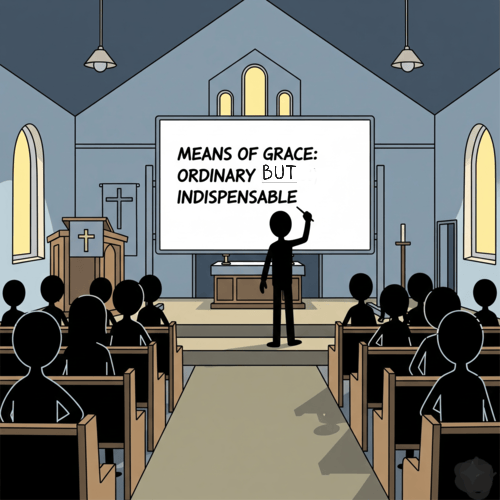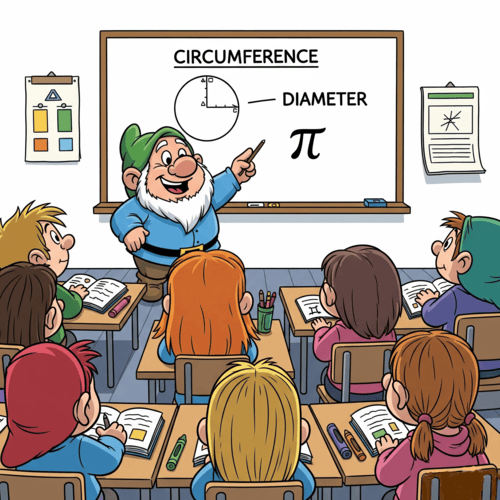1 Kings 7:23: Did God Get His Math Wrong?
ANSWERING CRITICS WHO SUGGEST GOD GOT THE VALUE OF PI WRONG
“Then he made the sea of cast metal. It was round, ten cubits from brim to brim, and five cubits high, and a line of thirty cubits measured its circumference.” (1 Kings 7:23, ESV)
This verse has sparked countless debates and provided ammunition for sceptics who claim the Bible contains mathematical errors. The challenge seems straightforward: if the bronze sea had a diameter of 10 cubits and circumference of 30 cubits, then dividing 30 by 10 gives us 3 for the value of pi. But we know pi equals approximately 3.14159. Did the inspired authors get their math wrong? Did God miscalculate?
DID GOD GET HIS MATH WRONG? THE TEXT IN CONTEXT
Before rushing to calculations, we must understand what 1 Kings 7:23 is actually trying to communicate. The passage sits within a detailed description of Solomon’s temple furnishings, not a geometry textbook or engineering manual. The author is providing architectural details for readers who wanted to understand the grandeur and magnificence of Israel’s temple.
The bronze sea was a massive ceremonial basin used by priests for ritual washing. Its description serves a specific literary purpose: demonstrating the impressive scale and craftsmanship of Solomon’s temple construction. The parallel account in 2 Chronicles 4:2 provides identical measurements, suggesting these numbers were intentionally chosen and consistently transmitted.
The original audience consisted of ancient Israelites familiar with construction terminology and measurement conventions of their day. They weren’t looking for mathematical precision but for a sense of the temple’s splendour and the care taken in its construction.
UNDERSTANDING ANCIENT MEASUREMENT PRACTICES
Ancient builders operated with practical, conventional measurements rather than theoretical precision. The Hebrew cubit itself wasn’t a standardised scientific unit but varied depending on context, region, and even individual rulers. Traditionally understood as the distance from elbow to fingertip, the cubit naturally varied from person to person and culture to culture, with some regions using longer “royal cubits” that were distinct from common cubits. Construction projects, especially large bronze castings, required workable measurements that craftsmen could actually use.
Throughout the ancient Near East, architectural descriptions regularly employed rounded numbers. This wasn’t carelessness but conventional practice. Large projects demanded practical measurements that workers could remember and implement. A bronze sea 30 cubits around and 10 cubits across communicated the essential information: this was a substantial, circular basin of impressive proportions.
Consider modern parallels: we still call lumber “2×4” even though it actually measures 1.5 by 3.5 inches. Construction “shortcuts” aren’t deceptions but practical conventions everyone understands. Similarly, ancient measurements prioritized utility over mathematical exactness.
SCRIPTURE’S ‘PHENOMENOLOGICAL’ LANGUAGE
The Reformed tradition has long recognised Scripture speaks truthfully using ordinary, observational language rather than technical scientific terminology. This principle, sometimes called “phenomenological accuracy,” means the Bible describes things as they appear to human observers using conventional language of the time.
We see this throughout Scripture. The sun “rises” and “sets” (Ecclesiastes 1:5), though we know the earth rotates. Isaiah speaks of earth’s “four corners” (Isaiah 11:12), using conventional directional language. Jesus describes stars “falling” from heaven (Matthew 24:29), employing apocalyptic imagery his hearers understood.
John Calvin captured this principle beautifully, noting God “lisps” to us like a parent speaking to a child. Divine accommodation means God condescends to communicate through human language and cultural conventions. The Holy Spirit inspired authors to write in ways their original audiences could understand and apply.
BB Warfield, the Princeton theologian, formulated this precisely: Scripture is accurate in all it affirms, but we must understand the nature of its affirmations. The question isn’t whether Scripture uses scientifically precise language, but whether it truthfully accomplishes its intended purpose.
A TECHNICAL SOLUTION: THE MEASUREMENTS MAY ACTUALLY BE PRECISE
Remarkably, the measurements in 1 Kings 7:23 may be mathematically exact when properly understood. If the 10-cubit measurement refers to the exterior diameter while the 30-cubit measurement refers to the interior circumference, the apparent discrepancy disappears.
Here’s the calculation: with a rim thickness of approximately 0.225 cubits, the interior diameter would be about 9.55 cubits. The circumference of this interior circle would be 9.55 × π = 30 cubits. The math works precisely!
This interpretation gains support from archaeological evidence about Bronze Age metalworking. Large bronze vessels required substantial wall thickness for structural integrity. In fact, the biblical text itself supports this reading, as 1 Kings 7:26 specifically mentions the sea’s thickness as “a handbreadth.”
Ancient craftsmen possessed sophisticated knowledge of metallurgy and engineering. They understood massive bronze castings needed thick walls to prevent cracking and collapse. The measurements may reflect careful engineering rather than approximation.
DID GOD GET HIS MATH WRONG? MULTIPLE SOLUTIONS, ONE CONCLUSION
Whether we understand 1 Kings 7:23 through conventional measurement practices, phenomenological language, or precise engineering calculations, the supposed mathematical error dissolves under careful examination. Each approach demonstrates apparent contradictions often reflect our misunderstanding rather than Bible errors.
The case study illustrates a broader principle: Scripture proves reliable when properly understood. The same God who inspired the mathematical precision of creation also inspired the biblical text. We need not choose between faith and careful scholarship when both point toward Scripture’s trustworthiness.
SCRIPTURE’S RELIABILITY VINDICATED
So did God get His math wrong? The 1 Kings 7:23 challenge, rather than undermining biblical authority, actually demonstrates Scripture’s remarkable reliability. Multiple viable solutions exist, each grounded in sound principles of interpretation and historical understanding. Whether through recognising ancient measurement conventions, appreciating Scripture’s phenomenological language, or discovering the mathematical precision hidden in the text, we find God’s word proves trustworthy.
This increases our confidence in tackling other apparent difficulties. Scripture rewards careful study and thoughtful analysis. The same God who measured the waters in the hollow of His hand (Isaiah 40:12) inspired a text that stands up to the most rigorous scrutiny. When we approach God’s word with both reverence and scholarship, we consistently discover apparent problems become opportunities to marvel at Scripture’s wisdom and reliability.
DID GOD GET HIS MATH WRONG? RELATED FAQS
What did major Reformed scholars say about this passage? John Calvin focused on the passage’s purpose of demonstrating the temple’s magnificence rather than providing mathematical precision. Matthew Henry similarly emphasised that Scripture uses “popular and customary” language appropriate to its time and audience. Both avoided getting caught up in mathematical technicalities, viewing such concerns as missing the text’s spiritual purpose.
- Why didn’t ancient biblical authors use more precise measurements if they knew better mathematical values? Ancient authors wrote for practical communication, not scientific treatises. Their audiences understood conventional measurements and weren’t expecting mathematical precision in architectural descriptions. Using exact mathematical values would have been culturally inappropriate and potentially confusing to readers who thought in terms of practical, rounded measurements.
- How do we know the ancient Israelites didn’t actually believe pi equalled exactly 3? Archaeological evidence shows ancient Near Eastern civilisations, including Israel’s neighbours, possessed sophisticated mathematical knowledge. Babylonian mathematicians used pi approximations closer to 3.125, and Egyptian builders demonstrated understanding of more precise ratios. The biblical authors were writing descriptively, not prescriptively about mathematical constants.
- Are there other examples in Scripture where rounded numbers create similar apparent discrepancies? Yes, Scripture frequently uses rounded numbers for practical communication. The Israelites are described as “600,000 men on foot” (Exodus 12:37), clearly a rounded figure. Census numbers often end in multiples of hundreds or thousands, indicating conventional rounding. Biblical genealogies sometimes skip generations, showing similar practical approaches to numerical precision.
- How does this interpretation affect our understanding of Bible inerrancy? It strengthens inerrancy by clarifying what Scripture actually claims. Inerrancy means Scripture is truthful in all it affirms, but we must understand the nature of those affirmations. When Scripture uses conventional measurements or phenomenological language, it’s being perfectly accurate according to its intended purpose and literary genre.
What archaeological evidence supports the technical solution involving rim thickness? Bronze Age metalworking artefacts show thick-walled construction was necessary for large vessels. Archaeological finds from Solomon’s era demonstrate sophisticated casting techniques requiring substantial wall thickness. The Laver Stands found at various Israelite sites show similar thick-walled construction, supporting the biblical description’s technical accuracy.
DID GOD GET HIS MATH WRONG? OUR RELATED POSTS
Editor's Pick

Should We Stop Using Male Pronouns for God? Why Do We Say No?
A friend of ours arrived eagerly at his first theology class in seminary. But he quickly discovered something troubling: the [...]

Did Old Testament Law Force Women to Marry their Rapists?
**Editor’s Note: This post is part of our series, ‘Satan’s Lies: Common Deceptions in the Church Today’… Viral misinformation abounds [...]

From Danvers To Nashville: Two Statements, One Biblical Vision
30 years separate the Danvers Statement on Biblical Manhood and Womanhood (1987) and the Nashville Statement on Human Sexuality (2017). [...]

The Nashville Statement: Why Affirm It Despite Media Backlash?
WHY DO REFORMED CHRISTIANS STAND BY THIS STATEMENT ON MARRIAGE AND GENDER? When the Nashville Statement was released in 2017, [...]

Who Is Belial? Solving The 2 Corinthians 6:15 Mystery
Belial: This name from the pages of Scripture chills the soul. Who is this mysterious figure Paul invokes in 2 [...]

Celibacy Or Castration: What Jesus Really Means in Matthew 19:12
One of Scripture's most shocking misinterpretations led theologian Origen to castrate himself in the third century. His tragic mistake? Taking [...]

Philippians 4:13: Did Paul Really Mean We Can Do ALL Things?
"I can do all things through Christ who strengthens me." It's on gym walls, graduation cards, and motivational posters everywhere. [...]

The Ordinary Means of Grace: Why Are They Indispensable?
ORDINARY MEANS FOR EXTRAORDINARY TRANSFORMATION What if God's most powerful work in believers' lives happens through the most ordinary activities? [...]

Is the Bible God’s Word? Or Does It Only Contain God’s Word?
The authority of Scripture stands at the crossroads of modern Christianity. While some argue the Bible merely contains God’s Word [...]

Will We Remember This Life in Heaven? What Isaiah 65:17 Means
"Will I remember my spouse in heaven? My children? Will the joy we shared on earth matter in eternity?" These [...]
SUPPORT US:
Feel the Holy Spirit's gentle nudge to partner with us?
Donate Online:
Account Name: TRUTHS TO DIE FOR FOUNDATION
Account Number: 10243565459
Bank IFSC: IDFB0043391
Bank Name: IDFC FIRST BANK






